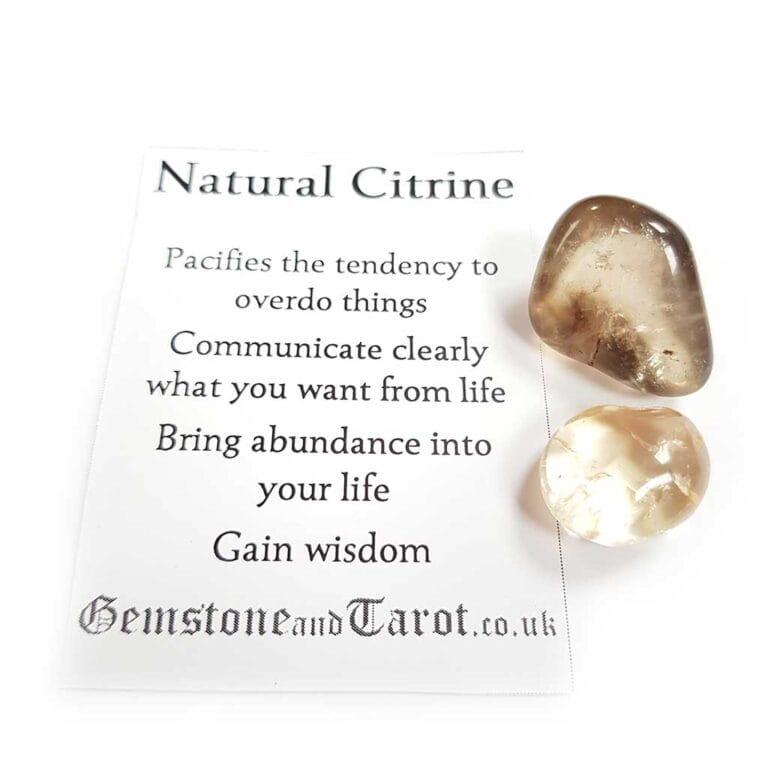About
Gemstone, Tarot and Healing grew from Amanda’s passion for crystals, tarot, and holistic healing. Together with Mark, who’s passion is tarot, magick, and the occult, they bring you a shopping experience to remember.
Enhance Your Well-Being with Ethically Sourced Products and Holistic Services in Liverpool
There is a fad on social media to warn others about Fake Citrine.
The reason for this accusation is that naturally it is very pale, but by heating this crystal to high temperatures, it turns a beautiful, golden yellow.
Citrine has been around for centuries, but heat treatment doesn’t make it fake.
I would like to put a case forward that Heat-Treated (HT) Citrine has a place in crystal healing.
In Gemmology, the definition of Citrine is a yellow to yellow-orange or yellow-green variety of Quartz crystal. Whether it got its colour naturally or artificially does not alter its name.
If you buy a piece of Citrine, and it’s made of yellow coloured glass, then yes, this would be fake Citrine. With the popularity of HT Citrine falling, the demand for natural Citrine will most likely increase the amount of fake Citrine on the market.
Enhancement of gemstones is an ancient process, making them more attractive to buyers. The more vibrant these crystals are, the more money they sell for. The jewellery trade has been relying on these methods for centuries. There is evidence that the carnelian used in Tutankhamun’s tomb shows signs of heat-treatment.

Natural Citrine does occur and it’s a pale yellow or honey coloured, often with smoky tones. The pieces that show vibrancy and clarity are rare and these will usually end up in the jewellery trade, thus commanding an extremely high price.
The vast majority of Citrine currently available is the heat-treated variety. The process involves heating poor quality Amethyst to change its colour, and thus increase its value. The demand for HT Citrine makes use of a worthless by-product of Quartz and Amethyst mining and an added income for miners in South America.
By contrast most of the natural Citrine appearing on the market seems to be from the Democratic Republic of Congo (DRC). Congolese mines have faced criticism for human rights abuses, corruption, environmental destruction, unsafe practices, and child labour. Unless the seller has seen the piece pulled out the ground, they will not know how ethical it is.
It seems counterintuitive that customers would want to buy potentially unethically crystals, rather than artificially altered ones.
Heat-treated Citrine has been available for centuries, and in the holistic sector it was almost impossible to find natural Citrine. Some of those calling out HT Citrine also claim that aura crystals have even more healing energy, due to the metals in the coating. The coating process involves the crystals being heated over 800°C, so basically the same as with Citrine.
Unless they specifically name it natural, you can assume that they are using HT in any healing or spiritual uses. So, in short, if you do not need natural Citrine, just use the heat-treated pieces for the following reasons: –
If someone tells you to buy real Citrine, try to work out the reasons why.
Some examples include below and you may be able to come up with more.
Whatever it is, don’t feel that HT Citrine is ‘fake’, because it isn’t!
One day someone will trademark a great name for it and its reputation, demand, and its price will go up.
I found this brief mineralogical explanation on the transformation of Amethyst and smoky Quartz to yellow form. It gives the scientific reasons for the colour change.
Gemstone, Tarot and Healing grew from Amanda’s passion for crystals, tarot, and holistic healing. Together with Mark, who’s passion is tarot, magick, and the occult, they bring you a shopping experience to remember.
Amanda’s services are situated between Broadgreen and Huyton, Liverpool, L16 – Full address is provided upon booking
| Cookie | Duration | Description |
|---|---|---|
| cookielawinfo-checkbox-analytics | 11 months | This cookie is set by GDPR Cookie Consent plugin. The cookie is used to store the user consent for the cookies in the category "Analytics". |
| cookielawinfo-checkbox-functional | 11 months | The cookie is set by GDPR cookie consent to record the user consent for the cookies in the category "Functional". |
| cookielawinfo-checkbox-necessary | 11 months | This cookie is set by GDPR Cookie Consent plugin. The cookies is used to store the user consent for the cookies in the category "Necessary". |
| cookielawinfo-checkbox-others | 11 months | This cookie is set by GDPR Cookie Consent plugin. The cookie is used to store the user consent for the cookies in the category "Other. |
| cookielawinfo-checkbox-performance | 11 months | This cookie is set by GDPR Cookie Consent plugin. The cookie is used to store the user consent for the cookies in the category "Performance". |
| viewed_cookie_policy | 11 months | The cookie is set by the GDPR Cookie Consent plugin and is used to store whether or not user has consented to the use of cookies. It does not store any personal data. |